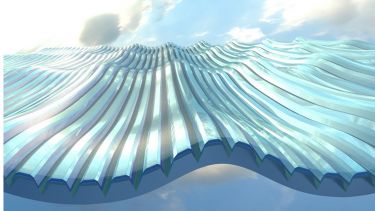An innovative new solar cell design which has the capability to drive down costs of solar cell manufacture, has been created by scientists at the University of Sheffield and energy technology company Power Roll.
In a study published in the journal Energy and Environmental Science, collaborating researchers from the University of Sheffield and Power Roll have demonstrated how a unique architecture based on a surface embossed with micro-grooves could also make solar power more efficient.
Researchers showed that by coating opposing walls of micro-grooves with different electrical contacts, and then filling the groove with a solution-processable semiconductor, it was possible to create a new type of back contacted solar cell.
We have developed a radically different architecture to make solar cells using a surface patterned by micro-grooves that individually are a fraction of the width of a human hair
Dr Trevor McArdle
Senior Research Scientist at Power Roll
The innovative 3D design removes many of the manufacturing process steps required by existing PV modules and allows new materials to be used that would not usually be appropriate in regular solar cells.
Professor David Lidzey, from the Department of Physics and Astronomy at Sheffield, who has led on the collaboration with Power Roll, said: “There is global interest in using solar cells to generate low carbon, green electricity. The design of the back contacted solar module is both innovative and elegant, and can potentially reduce optical losses within the device.’’
Power Roll Ltd predicts that solar modules produced using this design will weigh only a fraction of an equivalent-power conventional solar module which could benefit less developed and off grid areas of the world where it is not viable to transport heavy solar panels as well as a wide range of other applications.
Researchers said other benefits of Power Roll’s design include removal of expensive transparent conductive oxides, the use of simple and low cost electrical interconnections and the ability to tune electrical output to match user requirements.
Dr Trevor McArdle, Senior Research Scientist at Power Roll said: “Over the last 40 years, the majority of solar cells have been based on a conventional flat structure, in which layers of different materials are deposited one upon another to create the solar cell. However, we have developed a radically different architecture to make solar cells using a surface patterned by micro-grooves that individually are a fraction of the width of a human hair.”
Professor Lidzey, added: “The devices we have demonstrated with Power Roll, have a promising efficiency, whereby seven per cent of sunlight power falling onto a single photovoltaic micro-groove device is directly converted to electrical power, this is already around a third of what the best performing but expensive solar cells produce today.”
Building on the work published in this paper, the University of Sheffield and Power Roll have successfully produced working mini-module demonstrators. Power Roll is now focusing on scaling up the technology ready for commercialisation.
Neil Spann, CEO of Power Roll, said: “We believe that our patented architecture is a game changer. The market opportunities for our solar PV product are significant, including off-grid solutions, commercial and domestic systems, powering the internet of things, portable power generation and military applications. This technology will deliver significant economic and social benefits to end users.”




